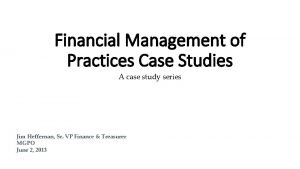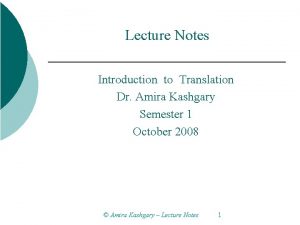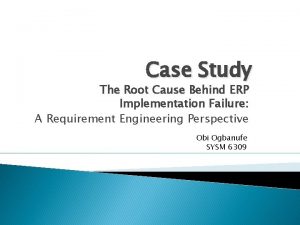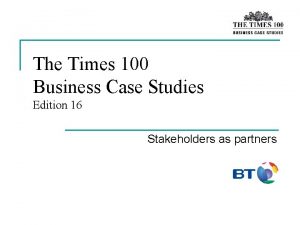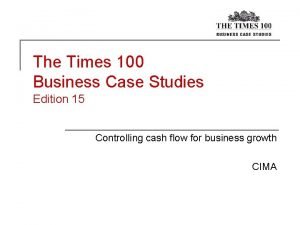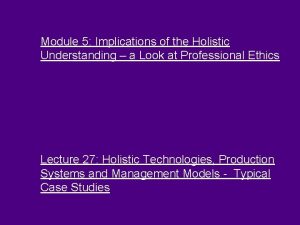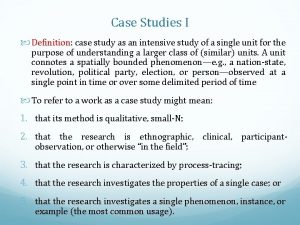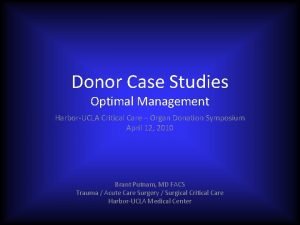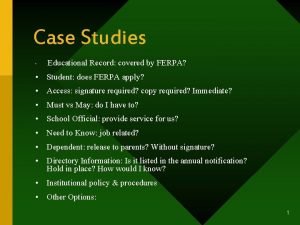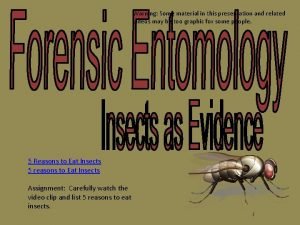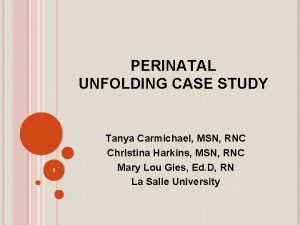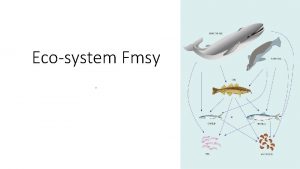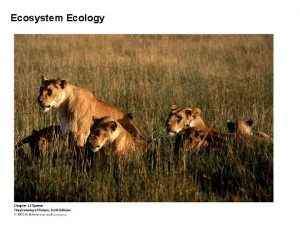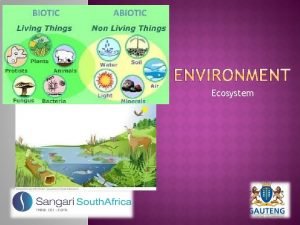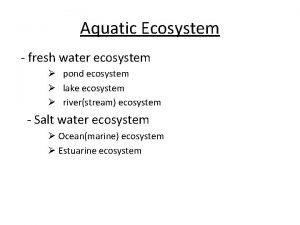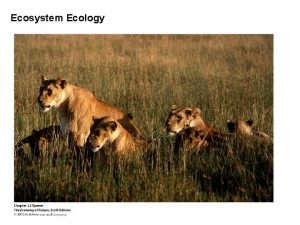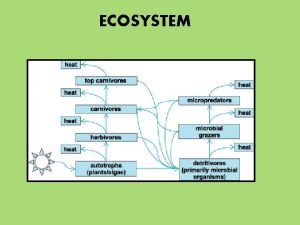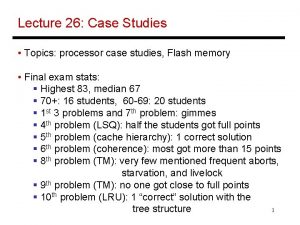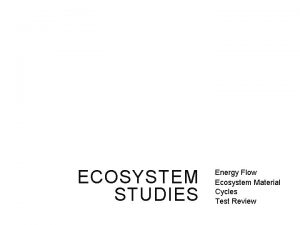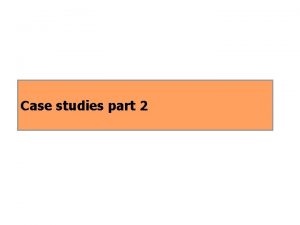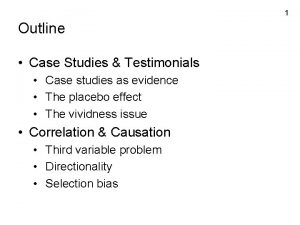Lecture 11 Implementation of Ecosystem Management Case Studies

































- Slides: 33

Lecture 11 Implementation of Ecosystem Management: Case Studies Kevin Crowe FORE 4212 25 November, 2004 1

Objectives l l Review 2 working examples of ecosystem management Demonstrate how ecosystem management initiatives have sprung from diverse origins – l 2 i. e. , outside of Ontario Illustrate innovation in managing all forest values

Case #1: The Lac Duparquet Forest Northwestern Quebec l Great variety of soil conditions and a forest mosaic characteristic of eastern boreal mixed -wood forest – l 3 Pine, spruce, birch, aspen, balsam fir, tamarack Allocated to Tembec (sawmills) and Nexfor (OSB mill)

Case #1: The Lac Duparquet Forest l 1996 Tembec and Nexfor gave up 8, 000 ha to allow creation of Lac Duparquet Research and Teaching Forest – – – l l l 4 University of Quebec at Montreal and University of Quebec in Abitibi took over management of the forest Yves Bergeron Quebec govt. gave 25 -year tenure, renewable every 5 years Universities manage and harvest the forest, selling wood to Tembec and Nexfor No stumpage fees charged by govt. Revenues are to pay for planning, silviculture, and graduate student research

Case #1: The Lac Duparquet Forest l Management Planning – – – 5 University researchers, and foresters from Tembec and Nexfor form the management team First management plan presented in 1998 Plan aimed to manage the forest through “emulation of natural disturbance” paradigm

Case #1: The Lac Duparquet Forest l Steps involved in developing and implementing the plan – – – 6 1. Characterization of the historic natural disturbance regime 2. Use forest ecosystem classification and fire cycle modeling 3. Associate forest types with cohorts 4. Develop a forest level management model 5. Use silvicultural treatments to attain landscape level objectives

Step #1. Characterization of the historic natural disturbance regime l Using soil pits, researchers reconstructed fire history and mapped it: – – l 7 Completed a detailed study of frequency, severity and burn patterns In this region, the regime was characterized by large crown fires Great variation in severity Return interval 140 years on avg. Used this as a benchmark on which to target forest age structure

Step # 2. Use forest ecosystem classification and fire cycle modeling l l First: regional scale ecosystem classification provided information of relative proportion of site types found in the area Using this, plus fire cycle information and knowledge of stand dynamics, they deduced: – 8 Natural forest age structure and composition targets

Step # 3. Associate forest types with cohorts l l l Stand development was partitioned into three development stages, or, cohorts 12 forest types, based on 3 different cohort types and ecosystem classification First cohort forest types (even-aged) – – l Second cohort forest types (uneven-aged) – – 9 tend to have an even aged structure and are composed of pioneer species These dominate first 100 years following fire consist of surviving canopy stems from the first cohort and either 1) tolerant softwoods that were present in the understory of the first cohort, or 2) trees recruited in the understory Uneven-aged structure

Step # 3. Associate forest types with cohorts – – – l Third cohort type (irregular stand structure) – – 10 Second cohort represents a mid-successional phase From 75 to 175 years after disturbance Mixed species, irregular structure the late successional phase First cohort canopy trees have died Balsam fir, eastern white cedar dominate in irregular stand structure Assumption is that wildfire and clearcut revert most forest types to first cohort type

Step # 4. Develop a forest level management model l 11 Developed an area-based forest simulation model that controls fluxes within and between forest types Partial cutting of first and second cohort types creates second and third types respectively Clearcutting in any cohort type creates first cohort type

Step # 4. Develop a forest level management model l Non spatial forest level model indicates at what period harvesting and recruitment should occur in each forest type, and over how much area in order to…. ? – Move from the present age structure and area to the target condition…which was based on? l l l 12 1. proportion of each ecosite type 2 fire history 3. stand dynamics

Step # 4. Develop a forest level management model l l 13 This is not unlike our approach using SFMM How does it differ?

How Does it Differ l l 14 1. Fire history data. 2. Emphasis on maintaining cohorts (stand structures) through partial cutting.

Step#5. Use silvicultural treatments to attain landscape level objectives l l l Given a target forest, with an inverse-J age-class distribution (or cohort distribution), there is likely to be a drop in AAC Especially in the Boreal, where short-lived species die before you can harvest them on extended rotations Therefore use silvicultural practices to minimize impact on AAC while still: – 15 Maintaining structural and compositional targets of over mature stands

First, second, and third cohorts attained using silvicultural treatments 16

Step#5. Use silvicultural treatments to attain landscape level objectives l Note: Little experience in partial cutting in the region – – – l l 17 Therefore outcomes of treatments were uncertain Therefore designed and implemented harvesting experiments Silvicultural trials were established in 1998 Larger operational trials on Tembec and Norbord’s areas Adaptive management approach

Case #1: The Lac Duparquet Forest l They also established a control area – l 18 2, 000 ha zoned for conservation to serve as a natural benchmark for environmental monitoring Used for fundamental studies in natural forest dynamics and ecosystem processes

Case #1: The Lac Duparquet Forest l l l 19 Testing the Triad Zoning Approach Quebec Govt. has been slow to create network of reserves Consensus is emerging that creation of such a network will require compensatory increase in intensive silviculture

Case #1: The Lac Duparquet Forest l l Recall triad approach, AKA, balanced forestry? Divide forest into zones – – – 20 1. Majority is in ecosystem management zone 2. Certain areas on productive sites, close to mills, are managed intensively 3. Ecologically significant or rare critical habitats are put into reserves

Case #1: The Lac Duparquet Forest l The division in this forest is – – – l 21 70% ecosystem management 25% reserve (half of which is non-productive) 5% intensive (all highly productive) Therefore, intensive must increase yield per ha 2 and half times over normal silviculture to “break even”, i. e. , sustain timber supply

l l 22 This is where the lecture ended. Students may ignore material beyond this point.

Case #2: Louisiana-Pacific in Swan Valley, Manitoba l l l 23 1994 FMA granted to LP: 2. 6 million ha, with productive land base of 584, 000 ha LP must build OSB mill in Swan Valley and develop a 10 -year management plan Plan was to be approved by Forestry Branch of Manitoba Natural Resources and Licensing Branch of Manitoba Environment And reviewed by Canadian Wildlife Service, Department of Fisheries and Oceans, In addition, LP had to produce an environmental impact assessment LP chose to embrace an ecosystem management approach to managing the forest

Case #2: Louisiana-Pacific in Swan Valley, Manitoba l Following the review period, a public environmental hearing process was conducted, by the Clean Environment Commission – – – 24 This allows interested parties to question the forest management plan and the environmental impact statement The hearings were well attended and lively Concerns expressed over annual harvest volumes, mill emissions, and LP’s track record of environmental violations in Colorado

Case #2: Louisiana-Pacific in Swan Valley, Manitoba l l Public and Community Involvement LP responded by developing a “Stakeholders Advisory Committee”, 1995 – – – 25 The SAC provides a forum for expression of values from various interest groups LP wished to identify any resources and land uses that may be “impacted” by the implementation of their plan LP also held annual open houses and met individually with environmental organizations

Case #2: Louisiana-Pacific in Swan Valley, Manitoba l l Operational Practices and Training Standard Operation Practices were developed in consultation with Stakeholders Advisory Committee. – – – 26 LP committed to train staff and operators in both operational and ecological aspects of forest management to minimize environmental impacts. E. g. , New operational practices on stream crossing installation, road construction, erosion control Staff attended courses on natural disturbance based approaches to forest management, riparian management, and role of public participation

Case #2: Louisiana-Pacific in Swan Valley, Manitoba l l Applied Management Clearcut harvest followed by natural regeneration was LP’s most common practice – – – 27 They implemented variable retention practices, i. e. , clearcuts with residual forest left in patches, to emulate natural disturbance LP operation supervisors were trained and audited (by third party) annually on correct implementation Blocks were rated on adherence to work permit instructions

Case #2: Louisiana-Pacific in Swan Valley, Manitoba l l Inventory and Monitoring Pre-harvest survey program was developed to determine distribution and abundance of wildlife habitat of every potential harvest site – – 28 These data were used with short and long term planning 18, 000 plots have been completed (vegetation, soil, timber, non-timber attributes measured) + 450 permanent plots (to act as controls)

Case #2: Louisiana-Pacific in Swan Valley, Manitoba l LP also developed a new Forest Lands Inventory Program – Three components l l 29 1. forest lands inventory 2. ecosite inventory 3. terrain and landform inventory This will provide the basis for planning on an ecosystem basis

Case #2: Louisiana-Pacific in Swan Valley, Manitoba l LP also committed (1997) to funding a bird monitoring program, to evaluate the effectiveness of variable retention – – – l 30 I. e. , adaptive management 2, 200 point count stations across the forest 218 species LP has reduced harvesting in May, June, and July– bird nesting season

Case #2: Louisiana-Pacific in Swan Valley, Manitoba l l Aquatic Ecosystems The potential for harvest effects related to water quality and peak flows were difficult to estimate without baseline data – 31 DFO allowed LP to operate on not more than 30% of a watershed (5 year delay for hardwood, 15 for conifer) until watershed impact analysis is completed by LP

Case #2: Louisiana-Pacific in Swan Valley, Manitoba l Research Program – – Priority is to understand natural disturbance regime of their region Collect historical data on l l 32 fire frequency, size, and severity Insect and disease dynamics

Case #2: Louisiana-Pacific in Swan Valley, Manitoba l Understand dynamics and successional pathways l l 33 Develop reliable targets for long term plans aimed at emulating natural disturbance In addition, scientific advisory committee is developing forestry effects monitoring program to provide adaptive management framework
 Best worst and average case
Best worst and average case Financial management case study
Financial management case study 01:640:244 lecture notes - lecture 15: plat, idah, farad
01:640:244 lecture notes - lecture 15: plat, idah, farad Translate
Translate Paradigm shift from women studies to gender studies
Paradigm shift from women studies to gender studies Erp implementation failure a case study
Erp implementation failure a case study Advantages of descriptive research
Advantages of descriptive research Times 100 case studies
Times 100 case studies The times 100 business case studies
The times 100 business case studies Holistic technology in professional ethics
Holistic technology in professional ethics Advantages and disadvantages of case control studies
Advantages and disadvantages of case control studies What is case series
What is case series Eu-gdpr-p
Eu-gdpr-p Gcse geography case studies
Gcse geography case studies Euthanasia case studies
Euthanasia case studies E procurement case studies
E procurement case studies Types of case studies
Types of case studies Case study explanation
Case study explanation The times 100 business case studies
The times 100 business case studies Nasa system failure case studies
Nasa system failure case studies Abo discrepancy
Abo discrepancy Chemistry ethics case studies
Chemistry ethics case studies Nspe ethics
Nspe ethics Goal2u
Goal2u Jmp case studies
Jmp case studies Case studies of rtos
Case studies of rtos Ferpa case studies
Ferpa case studies Social engineering case studies
Social engineering case studies Plagiarism
Plagiarism Digital marketing case studies 2012
Digital marketing case studies 2012 Forensic entomology double puzzle answers
Forensic entomology double puzzle answers Times 100 case studies
Times 100 case studies Ref impact case studies
Ref impact case studies Tanya carmichael
Tanya carmichael

